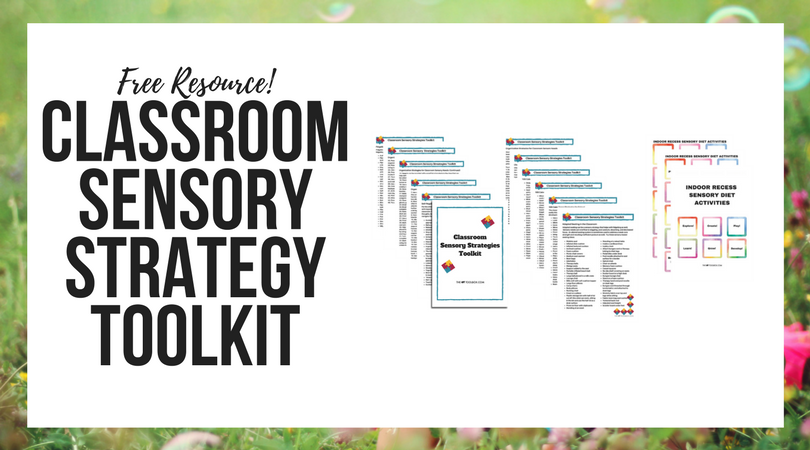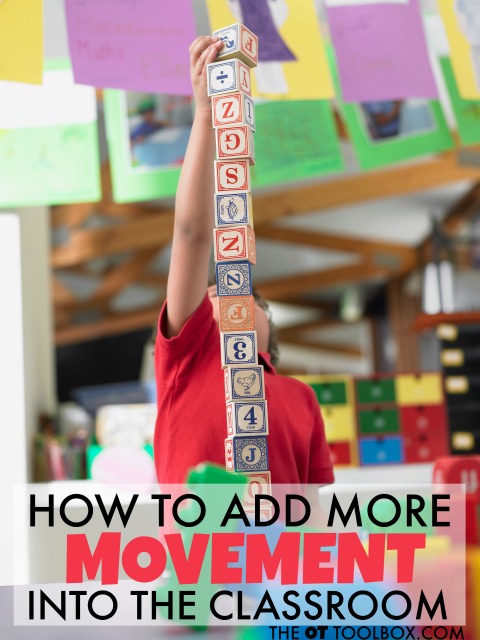Children today are experiencing less and less physical activity and more and more sedentary lifestyles that limit participation in many motor experiences. Children are spending more time in front of screens and less time climbing trees, rolling down hills, and in general less time outdoors. Physical activity is a vital part of health but for the student, movement in the classroom can have a big impact on learning. Gross motor games and activities can help.
There is much evidence of the link between movement and learning. For some students, movement breaks in the classroom are an essential part of regulation of sensory needs. Most students need a quick energizer to beat lethargy in a long school day at some point and brain breaks are a great answer to meet that need.
Below, you’ll find easy ways to incorporate movement into the classroom.
These are easy strategies that can be added at little cost. As much as most teachers and school based professionals would love extensive equipment or alternative seating and cushions in their classroom, these ideas are not always feasible. For these and other reasons, I’ve put together this list of ideas to add movement into the classroom environment.
Easy Ideas to Add Movement into the Classroom
You may have seen this video depicting movement in the classroom floating around on Facebook. Check it out. Does this sound familiar?
Add movement into learning- Incorporate gross motor movement into math when repeating math facts by incorporating whole-body games such as Simon Says (Students can perform specific motions when math facts are true, and perform other motor tasks when math facts are false.)
Daily Stretches
Afternoon Yoga Stretches
Dance Party Breaks
Brain break videos- Here are the best brain break videos on YouTube.
Themed Brain Breaks- Some ideas are these Bear Brain Breaks or these Farm Brain Breaks.
Role Play Activities for history, science, geometry, etc.
Large item manipulatives- Use creative items such as large cardboard boxes, printer paper boxes filled with newspapers, old phone books, etc.
Add in walks during the day.
Incorporate action rhymes into the morning routine or circle time.
Try these sensory motor activities for the classroom.
As students to move around the room to learn about specific items. Fall back on those places by asking the students to recall the part of the room they were in when they learned about that particular topic.
Move books or other items from the desk to a different part of the room so that students need to get up and walk to the back of the room to get their math workbook.
Try inexpensive seating tools such as this DIY sensory seating idea.
Utilize extra recess as a reward.
Create a fidget toolbox in the classroom for movement needs while sitting at desks.
Try a ball toss game with partners when working on learning facts or spelling.
Ask students to perform jumping jacks, clapping, running in place, or hopping when spelling words as a group.
Add movement requirements within a multi-step project- Students can complete a worksheet, then get up and place it in a bin across the room, then walk to another center to gather materials needed for their next assignment, then return to their desk.
Ask students to assist in handing out materials and papers.
Place a math problem at each student’s desk. Each child can copy the problem to another sheet of paper and complete the problem. Then, they can move to the next desk and complete that problem. Ask them to move to each desk until they have solved all of the problems.
Students can place their chairs on their desks at the end of each day and remove them at the beginning of each day.
When walking from classroom to classroom, students can all walk on their toes. Other ideas: walk toe to heel (for short trips down the hall), penguin waddle, walk with extra large steps, or other creative movement ideas.
Students can carry bins of materials needed for each day from their cubby to their desk.
Borrow a swivel seat from the computer lab or office. Use the seat as an alternative seat for different students throughout the day.
Try Indoor Ice Skating before a learning task- In the classroom, use a sheet of paper under each foot as students “skate” in the classroom for 5 minutes.
Raise the desks and allow students to stand for reading/writing/worksheets/learning activities.
Use easels in the classroom.
Encourage wall writing by taking paper to the walls and asking students to write at the wall.
Allow prone writing and reading (lay on stomach on the floor).
Use a therapy ball as a seat or as a movement area in the classroom.
What are your favorite ways to add movement to the classroom?
You may also be interested in the free printable packet, The Classroom Sensory Strategy Toolkit.
-
Fidgeting Tools for the Classroom
-
Adapted Seating Strategies for the Classroom
-
Self-Regulation in the Classroom
-
105 Calm-down Strategies for the Classroom
-
Chewing Tools for Classroom Needs
-
45 Organizing Tools for Classroom Needs
-
Indoor Recess Sensory Diet Cards


Colleen Beck, OTR/L has been an occupational therapist since 2000, working in school-based, hand therapy, outpatient peds, EI, and SNF. Colleen created The OT Toolbox to inspire therapists, teachers, and parents with easy and fun tools to help children thrive. Read her story about going from an OT making $3/hour (after paying for kids’ childcare) to a full-time OT resource creator for millions of readers. Want to collaborate? Send an email to contact@theottoolbox.com.







